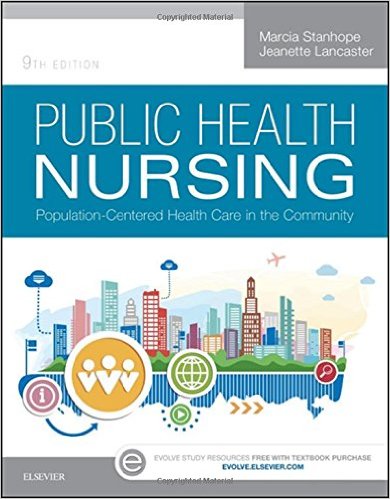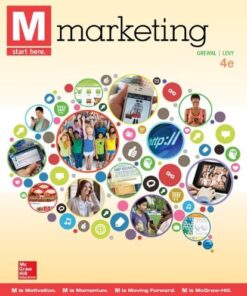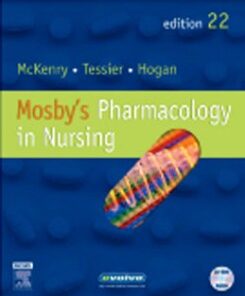Public Health Nursing Population-Centered 9th Edition Stanhope Lancaster Test Bank
$35.00
Public Health Nursing Population-Centered 9th Edition Stanhope Lancaster Test Bank
All resources are in electronic format and can be downloaded from your account or email – How to Download. Payments will be processed instantly after checkout. Please note that all sales are final and non refundable. If you still have questions, find answers on our FAQ page or just send us an email at [email protected], we will respond as soon as possible.
Chapter 03: The Changing U.S. Health and Public Health Care Systems
Stanhope: Public Health Nursing: Population-Centered Health Care in the Community, 9th Edition
MULTIPLE CHOICE
1. In the United States, the majority of health care dollars are spent on:
a. prescription drugs.
b. hospital care.
c. physician services.
d. public health services (PHSs).
ANS: B
The largest share of health care expenditures goes to pay for hospital care, with physician services the next largest item. The money spent for PHSs is significantly lower than the other categories of expenditures. Other significant drivers of the increasingly high cost of health care include prescription drugs, technology, and chronic and degenerative disease.
DIF: Cognitive level: Remembering REF: p. 48
TOP: Nursing process: Assessment
MSC: NCLEX: Safe and Effective Care Environment: Management of Care
2. The number of uninsured Americans has dramatically increased because:
a. Medicare took over payment of health care costs.
b. with a declining population, the costs for health care rose.
c. nursing salaries greatly increased, causing health care costs to rise.
d. health insurance coverage was dropped from employment-based health plans.
ANS: D
Although the majority of Americans continue to obtain health insurance from their employer as a benefit, employment does not guarantee insurance. Employer-sponsored health insurance is sensitive to both the general economy and changes in health insurance premiums. As costs for insurance premiums rose, employers either shifted more of these costs to their employees or declined to offer employment-based health coverage at all. Medicare provides coverage only to the elderly and other special populations. The costs for health care are continuing to rise regardless of the size of the population. There has not been a significant change to nursing salaries, and a change in nursing salaries would not impact the number of uninsured Americans.
DIF: Cognitive level: Understanding REF: p. 49
TOP: Nursing process: Assessment
MSC: NCLEX: Safe and Effective Care Environment: Management of Care
3. A nurse is working with a community to decrease the occurrence of influenza. Which of the following U.S. Department of Health and Human Services (USDHHS; or simply HHS) goals is being applied?
a. Strengthen Health Care
b. Advance the Health, Safety, and Well-being of the American People
c. Increase Efficiency, Transparency, Accountability, and Effectiveness of HHS Programs
d. Advance Scientific Knowledge and Innovation
ANS: B
One of the objectives of Advance the Health, Safety, and Well-being of the American People is to reduce the occurrence of infectious diseases. The goal of Strengthen Health Care focuses on improving health care services, quality, and coverage. The goal of Increase Efficiency, Transparency, Accountability, and Effectiveness of HHS Programs focuses on improving programming and application of found data. The goal of Advance Scientific Knowledge and Innovation focuses on scientific discovery and application of the new knowledge.
DIF: Cognitive level: Applying REF: p. 52 (Box 3-2)
TOP: Nursing process: Implementation
MSC: NCLEX: Health Promotion and Maintenance
4. According to the 1999 Institute of Medicine report, as many as 98,000 deaths each year could be attributed to:
a. cardiovascular disease.
b. obesity.
c. medical error.
d. drug overdose.
ANS: C
In 1999 it was thought that our health care system was expensive and that access and quality were not optimal, but we had not considered this important fact: many people die of preventable medical errors in the United States. This number is not the correct statistic for cardiovascular disease, obesity, or drug overdose.
DIF: Cognitive level: Remembering REF: p. 49
TOP: Nursing process: Assessment
MSC: NCLEX: Safe and Effective Care Environment: Management of Care
5. Residents of rural communities report that they must travel for long distances to obtain health care services. As a result, they seek health care only for emergencies and severe illnesses. Which aspect of the health care system in the United States is illustrated in this situation?
a. Access to care
b. Cost
c. Quality
d. Advances in technology
ANS: A
One significant problem is poor access to care. Access can refer to inability to pay for care and inability to access care. Cost refers to the health care expenditures that happen to pay for the services received. Quality refers to the quality of health care that is provided. Advances in technology refer to the medical advancements made to treat diseases.
DIF: Cognitive level: Analyzing REF: pp. 48-49
TOP: Nursing process: Assessment
MSC: NCLEX: Safe and Effective Care Environment: Management of Care
6. A nurse is exploring a job opportunity at a community health center. Which of the following expectations would the nurse have about the center?
a. Would be located in a large metropolitan area
b. Provides care only to the economically disadvantaged
c. Offers comprehensive primary care services and supportive services
d. Is used for preventive services such as flu shots
ANS: C
Community health centers serve the entire community for primary health care (PHC) services, regardless of income. They are located in a high need or medically underserved community, which can be urban or rural.
DIF: Cognitive level: Applying REF: p. 49
TOP: Nursing process: Assessment
MSC: NCLEX: Safe and Effective Care Environment: Management of Care
7. A nursing program has initiated a recruitment campaign focusing on increasing the minority students in its program. Which of the following best describes the rationale for this program?
a. The number of minority versus non-minority nurses should be equal.
b. Minority health care professionals who share the same culture with the clients may provide more effective care.
c. The profession should be more diverse.
d. Minority nurses can mentor other nurses when providing care for diverse populations.
ANS: B
It is thought that increasing minority representation in the health workforce not only is a commitment to diversity, but also will improve the health care delivery system. Minority health professionals can be expected to practice in underserved areas at a greater rate and health professionals who share the same culture and language with the clients they serve can provide more effective care. It has been suggested that the number of minority nurses should be representative of the population served rather than there being equal numbers of minority and nonminority nurses. Minority nurses are able to mentor other nurses; however, is not the main reason that there is a focus on increasing recruitment of minorities.
DIF: Cognitive level: Applying REF: p. 47
TOP: Nursing process: Planning
MSC: NCLEX: Safe and Effective Care Environment: Management of Care
8. A community health nurse is utilizing telehealth. Which of the following best describes the rationale for its use?
a. Enables clients to get nursing care in their homes
b. Substitutes for health department delivered care
c. Improves access to care in rural areas
d. Replaces face-to-face care for those who cannot afford it
ANS: C
Telehealth provides increased access to health care by the use of a computer monitor and telephone line. It is useful for monitoring clients with chronic disease, but is not a substitute for health care. Telehealth may or may not be accompanied by home care nursing.
DIF: Cognitive level: Applying REF: p. 47
TOP: Nursing process: Implementation
MSC: NCLEX: Safe and Effective Care Environment: Management of Care
9. One of the goals of the World Health Organization (WHO) is to:
a. provide PHC services to everyone.
b. prevent outbreaks of disease.
c. prevent the transmittal of communicable disease among nations of the world.
d. provide humanitarian support in times of disaster.
ANS: A
The WHO adopted a resolution in 1977 accepting the goal of attaining a level of health that permitted all citizens of the world to live socially and economically productive lives. This has been adapted to meet the needs of the new century and was deemed “Health for All in the 21st Century.” The focus of this initiative is PHC services. The WHO does not prevent outbreaks of disease, prevention, transmittal of disease, or provide humanitarian support.
DIF: Cognitive level: Understanding REF: p. 54
TOP: Nursing process: Assessment
MSC: NCLEX: Safe and Effective Care Environment: Management of Care
10. A public health agency is considering implementing an electronic health record. Which of the following best describes one of the benefits the agency will experience?
a. Facilitation of interprofessional care
b. Improved client compliance with medical regimens
c. Cost savings to the agency
d. Compliance with the Joint Commission of Accreditation of Healthcare Organizations (JCAHO) standards
ANS: A
The electronic medical record facilitates interprofessional care in chronic disease management and coordination of referrals; 24-hour availability of records with downloaded laboratory results and up-to-date assessments; incorporation of protocol reminders for prevention, screening, and management of chronic disease; improvement of quality measurement and monitoring; and increased client safety and decline in medication errors. There is no data to support that the agency will have improved client compliance or cost savings. Electronic medical records are not a requirement by JCAHO.
DIF: Cognitive level: Applying REF: pp. 47-48
TOP: Nursing process: Planning
MSC: NCLEX: Safe and Effective Care Environment: Management of Care
11. A nurse interacts with a 25-year-old woman at a community health center who is obtaining a gynecological examination and birth control pills. Which of the following types of care is the client receiving?
a. Tertiary health care
b. Public health care
c. PHC
d. Specialized care
ANS: C
By definition, PHC includes basic health care services with the emphasis on prevention. Tertiary health care is highly specialized medical care. Public health care focuses on care for populations. Specialized care focuses on only one aspect of a patient’s health.
DIF: Cognitive level: Applying REF: p. 50
TOP: Nursing process: Implementation
MSC: NCLEX: Safe and Effective Care Environment: Management of Care
12. A client is receiving PHC services. Which of the following expectations would the client have?
a. The care would be provided by a physician.
b. Private insurance would be necessary to receive care.
c. The emphasis of care provided would be on prevention.
d. A referral would be made to a specialist after receiving services.
ANS: C
The focus of PHC is a broad range of services that are designed to be affordable for the recipients of the care and the governments who provide them. The emphasis of care is on prevention and the means of providing the care is based on practical, scientifically sound, culturally appropriate, and socially acceptable methods. All clients can receive PHC services regardless of insurance status. Those receiving primary care services may or may not need referral to a specialist.
DIF: Cognitive level: Applying REF: p. 54
TOP: Nursing process: Implementation
MSC: NCLEX: Safe and Effective Care Environment: Management of Care
13. A nurse who was working in public health care has gotten a new job in primary care. Which of the following differences would be seen by the nurse in this new care setting?
a. Focus on individuals
b. Services provided by specialists
c. Autonomy in the practice setting
d. Community focused care is provided
ANS: A
Primary care focuses on individuals. It is also provided by generalists, is dominated by health care professionals, and is not community focused.
DIF: Cognitive level: Analyzing REF: p. 47 & p. 54
TOP: Nursing process: Assessment
MSC: NCLEX: Safe and Effective Care Environment: Management of Care
14. What initiative began as a result of a resolution adopted by the WHO in 1977?
a. Declaration of Alma Ata
b. Medicare
c. Healthy People
d. PHC movement
ANS: D
The WHO adopted a resolution accepting the goal of attaining a level of health that permitted all citizens of the world to live socially and economically productive lives. The name of the resolution that was adopted was the Declaration of Alma Ata. Medicare began as part of the Social Security Act. The Healthy People initiative began as part of the 1979 Surgeon General’s Report addressing the health needs of Americans.
DIF: Cognitive level: Understanding REF: p. 54
TOP: Nursing process: Assessment
MSC: NCLEX: Safe and Effective Care Environment: Management of Care
15. PHC in the United States:
a. has dramatically improved since the passage of the Declaration of Alma Ata.
b. focuses on the use of government-funded insurance programs.
c. lacks community participation and a multidisciplinary health care delivery team.
d. utilizes Preferred Provider Organizations to meet needs of the citizens.
ANS: C
Although PHC has been endorsed by the United States, it faces many challenges. PHC emphasizes broad strategies, community participation, self-reliance, and a multidisciplinary health care delivery team; however, this is not the primary method of health care delivery in the United States.
DIF: Cognitive level: Understanding REF: p. 54
TOP: Nursing process: Assessment
MSC: NCLEX: Safe and Effective Care Environment: Management of Care
16. A community health nurse reviews Healthy People 2020 when considering the health needs that will be addressed in the community. Which goal would the nurse find in this document?
a. Promote healthy behaviors for children
b. Cure cancer
c. Eliminate health disparities
d. Provide primary care to all citizens
ANS: C
Elimination of preventable disease, disability, injury, premature death; achievement of health equity; elimination of health disparities; and creation of social and physical environments that will promote good health and healthy development and behavior at every stage of life are the four major goals cited in Healthy People 2020.
DIF: Cognitive level: Understanding REF: pp. 54-55
TOP: Nursing process: Assessment
MSC: NCLEX: Health Promotion and Maintenance
17. An 80-year-old woman comes to the community health center with a large bag of medications. She tells the nurse she can no longer afford these medications because her only income is Social Security. Which statement is the best response by the nurse?
a. “Let’s go through these medications and see which ones we can delete.”
b. “You can get these medicines at this clinic for free.”
c. “Let’s see if we can get some help from Medicare to pay for these medications. I will refer you to our social worker.”
d. “These medications are important. Do your best to pay for them.”
ANS: C
This elderly patient probably is eligible for benefits through Part C, the Medicare Advantage program, but often a patient needs help negotiating the system. The Medicare Advantage program incorporates private insurance plans into the Medicare program including HMO and PPO managed care models and private fee-for-service plans. In addition, Medicare Part D has been added to cover prescriptions. These plans receive payments from Medicare to provide Medicare benefits, including hospital, physician, and often, prescription drug benefits. Finding prescriptive coverage through an insurance plan is a better choice than eliminating medications, trying to get medications for free (which is only a short-term solution in most cases), and telling the client to find a way to pay for the medications when she does not have the resources.
DIF: Cognitive level: Analyzing REF: p. 50
TOP: Nursing process: Assessment
MSC: NCLEX: Safe and Effective Care Environment: Management of Care
18. A nursing student is researching advanced practice nursing options. Which of the following discoveries would most likely be made by the nursing student?
a. Nurse practitioners may work independently depending on the state practice act.
b. Certified nurse midwives have limited prescriptive authority.
c. Clinical nurse specialists typically provide primary care services.
d. The Doctorate in Nursing Practice emphasizes the importance of research.
ANS: A
Nurse practitioners may work as independent practitioners and can be reimbursed by Medicare or Medicaid for services rendered. Certified nurse midwives have prescriptive authority in some form in all states. Clinical nurse specialists may provide primary care services, but often work in consultation, research, education, and administration. The Doctorate in Nursing Practice role is a clinical role.
DIF: Cognitive level: Applying REF: p. 47
TOP: Nursing process: Assessment
MSC: NCLEX: Safe and Effective Care Environment: Management of Care
19. A nursing student interviews a member of the local congressional district to learn more about the health care system in the United States. Which statement made by the congressman would be accurate?
a. “Managed care was short-lived because too many consumer groups endorsed the plans.”
b. “Under managed care, clients had unlimited access to providers of their choice.”
c. “Managed care failed because Americans were used to free access to providers of their choice.”
d. “Managed care in the United States has been replaced by the Affordable Health Care for America Act.”
ANS: C
Managed care has not become prominent as the original concept outlined. Consumer groups were not only accustomed to freedom of choice and unlimited service, but they did not like the ideas of short-stay maternity care and denial of bone marrow transplantation for breast cancer patients, thus managed care failed in the United States. The Affordable Care Act has not replaced managed care.
DIF: Cognitive level: Analyzing REF: p. 50
TOP: Nursing process: Assessment
MSC: NCLEX: Safe and Effective Care Environment: Management of Care
20. The federal agency of the public health system that is most involved with the health and welfare of United States citizens is the:
a. Centers for Medicaid and Medicare Services.
b. U. S. Department of Health and Human Services.
c. U. S. Public Health Service (USPHS; or simply PHS).
d. Health Resources and Services Administration.
ANS: B
The U. S. Department of Health and Human Services is charged with regulating health care and overseeing the health status of Americans. The Centers for Medicare and Medicaid Services develops and oversees the rules and regulations specific to these two insurance programs. The PHS is a major component of the Department of Health and Human Services. The PHS consists of eight agencies: (1) Agency for Healthcare Research and Quality, (2) Agency for Toxic Substances and Diseases Registry, (3) Centers for Disease Control and Prevention, (4) Food and Drug Administration, (5) Health Resources and Services Administration, (6) Indian Health Service, (7) National Institutes of Health, and (8) Substance Abuse and Mental Health Services Administration.
DIF: Cognitive level: Understanding REF: p. 50
TOP: Nursing process: Assessment
MSC: NCLEX: Safe and Effective Care Environment: Management of Care
21. A nurse works to promote the passage of a public health law to protect the health of the community. Which of the following would the nurse most likely be promoting?
a. Requiring all persons to have health insurance coverage
b. Administering flu shots in the late fall and early winter
c. Mandating immunizations for all children entering kindergarten
d. Monitoring and licensing nuclear power plants
ANS: C
Public health laws protect the community. Required immunizations are an example. Requiring health insurance coverage would not protect the community. Administration of flu shots is not promotion of a law. Monitoring and licensing nuclear power plants are beyond the scope of public health.
DIF: Cognitive level: Analyzing REF: p. 50
TOP: Nursing process: Implementation
MSC: NCLEX: Safe and Effective Care Environment: Management of Care
22. A nurse is working in a state health department. Which of the following programs would the nurse most likely be working with?
a. Senior health
b. Dental services
c. HIV/AIDS service
d. Mental health
ANS: C
Typical programs in a state health department include: communicable disease service, HIV/AIDS service, and budget and finance. Senior health, dental health, and mental health are typically found in a local health department.
DIF: Cognitive level: Applying REF: pp. 52-53
TOP: Nursing process: Implementation
MSC: NCLEX: Safe and Effective Care Environment: Management of Care
23. A nurse is employed by the Department of Homeland Security. Which of the following actions would be expected by this department?
a. Prevention and protection against terrorist attacks
b. Regulation of licensure of medical personnel
c. Inspection of the safety of food and cosmetics
d. Regulation of managed care organizations
ANS: A
The Department of Homeland Security was created after the terrorist attacks of September 11, 2001. Its mission is to prevent and deter terrorist attacks and to protect against and respond to threats and hazards to the nation. Regulating the licensure of medical personnel, inspecting the safety of food and cosmetics, and regulating managed care organizations are not responsibilities of this department. These activities are regulated by other state or federal government agencies.
DIF: Cognitive level: Applying REF: pp. 50-52
TOP: Nursing process: Implementation
MSC: NCLEX: Safe and Effective Care Environment: Management of Care
MULTIPLE RESPONSE
1. What are some of the untoward events categorized in the Institute of Medicine (IOM) report about medical errors? (Select all that apply.)
a. Wrong-site surgery
b. Adverse drug events
c. Improper transfusions
d. Restraint related deaths
e. Poor staffing patterns
ANS: A, B, C, D
The untoward events of wrong-site surgery, adverse drug events, improper transfusions, and restraint-related deaths are listed in the IOM report. Although poor staffing patterns may result in medical error, this is not one of the untoward events discussed in this report.
DIF: Cognitive level: Understanding REF: p. 49
TOP: Nursing process: Assessment
MSC: NCLEX: Safe and Effective Care Environment: Management of Care
2. A nurse is entering the health care workforce. Which of the following expectations should the nurse have for the workforce? (Select all that apply.)
a. There is a shortage of nurses in the United States.
b. Schools of nursing turn away qualified applicants due to lack of faculty and limitations of clinical sites.
c. By 2016 there are expected to be 527,000 new nursing positions.
d. More students are choosing laboratory science, pharmacy technology, and radiology technology over nursing.
e. There is a shortage of physician specialists in the United States.
ANS: A, B, C
The first three options are true. The laboratory science, pharmacy technology, and radiology technology programs have all seen declining enrollments. There is a shortage of primary care physicians as more physicians are choosing to specialize.
DIF: Cognitive level: Applying REF: p. 47
TOP: Nursing process: Assessment
MSC: NCLEX: Safe and Effective Care Environment: Management of Care
Be the first to review “Public Health Nursing Population-Centered 9th Edition Stanhope Lancaster Test Bank” Cancel reply
Related products
Test Bank












Reviews
There are no reviews yet.